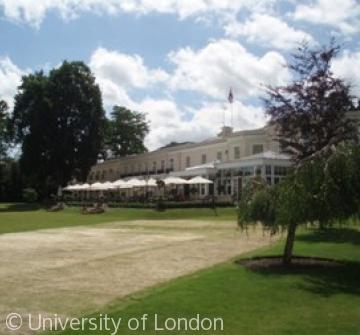Civil War in Henley

Image: Phyllis Court as rebuilt in the 1840s. Its predecessor was garrisoned and fortified during the Civil War.
Henley's riverside location between London and Oxford gave it a prominent role in the Civil War, particularly from 1642 when Oxford became the Royalist capital, while London remained with Parliament. Towns such as Reading were equally crucial, along with fortifiable riverside houses such as Greenlands a little way downstream. Both became Royalist outposts until seized by Parliament during 1644. Henley's significance was summed up by the Parliamentary commander Sir James Harrington, who recommended strengthening it: 'in order to hinder the great [river] trade ... between Oxford and London, as also for the well-being of Reading and Abingdon, the great supplies of corn and wood for London, and ... [Henley's] nearness to the enemy'. . Phyllis Court had already been fortified 'to watch the garrison of Greenland', and Henley remained a Parliamentarian stronghold until hostilities ended in 1646. Long before then the town experienced comings and goings by both sides. Prince Rupert had forces there in 1642 and 1643, when he had a man hanged from a tree at Northfield End, and in January 1643 there was a skirmish when Royalists trying to enter the town up Duke Street were met with Parliamentarian cannon fire. Victims of the carnage were buried in Henley churchyard soon after. The corporation minute books suggest that routine business continued much as usual, and Henley undoubtedly suffered less than places such as Reading. But even so the disruption and uncertainty must have been serious. In August 1642 the warden and corporation complained of the 'great peril' caused by the 'passing to and through our county of ... disorderly trains of armed men', and before Henley became a Parliamentary stronghold the townspeople must have been in a constant state of anxiety as to which side would visit next, what damage they would inflict and what goods they would carry off. Garrisoning Phyllis Court brought different woes, including frequent pillaging and increasingly mutinous behaviour from the underpaid soldiers. The commander of the garrison for part of this time was Bulstrode Whitelocke, owner of Phyllis Court and of nearby Fawley Court, and lord of Henley manor. Whitelocke did what he could, but with limited success. In one episode a woman who had complained of mounting taxation was condemned to have her tongue nailed to a roadside signpost on market day, with a paper describing her 'crime' fixed to her back. [See source]. The general economic dislocation was presumably longer lasting. Damage to Whitelocke's houses, lands and income caused him long-term problems, and though the river remained in constant use normal trade was virtually suspended. Henley bridge (like others in the area) suffered serious damage, but seems to have been fairly quickly repaired. The town's political allegiance, if any, is unclear, although we might expect tradesmen and merchants with London connections and possibly Puritan tendencies to be broadly sympathetic to Parliament. Even so, such sympathies may not have been universal. In the aftermath a handful of Henley people were fined for having helped the Royalists, and in 1655 there were attempts to oust one John Tyler (apparently a Presbyterian) from the corporation, and replace him with a man claimed to be a 'cavalier'. But the circumstances are unclear, and of the Royalist collaborators some at least may acted under duress. Whitelocke himself was a committed but moderate Parliamentarian who abhorred the war, and spent much of the 1640s and 1650s pressing for compromise. By contrast his near neighbour Lord Lovelace (died 1670) was a staunch Royalist, which did not prevent the two of them maintaining cordial relations in the 1650s. Many other townspeople probably avoided extremes, keeping their heads down as best they could – which is not to deny that the town may have contained partisans for both sides. . For an account with full references, see our forthcoming EPE paperback Henley-on-Thames: Town, Trade and River (to be published by Phillimore late 2009)
Content generated during research for the paperback book 'Henley-on-Thames: Town, Trade and River' (ISBN 13 : 978-1-86077-554-3) for the England's Past for Everyone series


